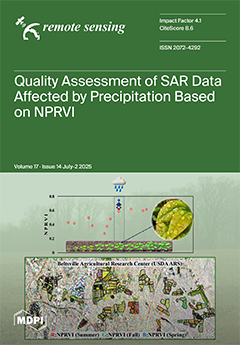Light Detection and Ranging (LiDAR) provides three-dimensional information that can be used to extract tree parameter measurements such as height (H), canopy volume (CV), canopy diameter (CD), canopy area (CA), and tree stand density. LiDAR data does not directly give diameter at breast
[...] Read more.
Light Detection and Ranging (LiDAR) provides three-dimensional information that can be used to extract tree parameter measurements such as height (H), canopy volume (CV), canopy diameter (CD), canopy area (CA), and tree stand density. LiDAR data does not directly give diameter at breast height (DBH), an important input into allometric equations to estimate biomass. The main objective of this study is to estimate tree DBH using existing allometric models. Specifically, it compares three global DBH pantropical models to calculate DBH and to estimate the aboveground biomass (AGB) of the Lake Broadwater Forest located in Southeast (SE) Queensland, Australia. LiDAR data collected in mid-2022 was used to test these models, with field validation data collected at the beginning of 2024. The three DBH estimation models—the Jucker model, Gonzalez-Benecke model 1, and Gonzalez-Benecke model 2—all used tree H, and the Jucker and Gonzalez-Benecke model 2 additionally used CD and CA, respectively. Model performance was assessed using five statistical metrics: root mean squared error (RMSE), mean absolute error (MAE), mean absolute percentage error (MAPE), percentage bias (MBias), and the coefficient of determination (R
2). The Jucker model was the best-performing model, followed by Gonzalez-Benecke model 2 and Gonzalez-Benecke model 1. The Jucker model had an RMSE of 8.7 cm, an MAE of −13.54 cm, an MAPE of 7%, an MBias of 13.73 cm, and an R
2 of 0.9005. The Chave AGB model was used to estimate the AGB at the tree, plot, and per hectare levels using the Jucker model-calculated DBH and the field-measured DBH. AGB was used to estimate total biomass, dry weight, carbon (C), and carbon dioxide (CO
2) sequestered per hectare. The Lake Broadwater Forest was estimated to have an AGB of 161.5 Mg/ha in 2022, a Total C of 65.6 Mg/ha, and a CO
2 sequestered of 240.7 Mg/ha in 2022. These findings highlight the substantial carbon storage potential of the Lake Broadwater Forest, reinforcing the opportunity for landholders to participate in the carbon credit systems, which offer financial benefits and enable contributions to carbon mitigation programs, thereby helping to meet national and global carbon reduction targets.
Full article





